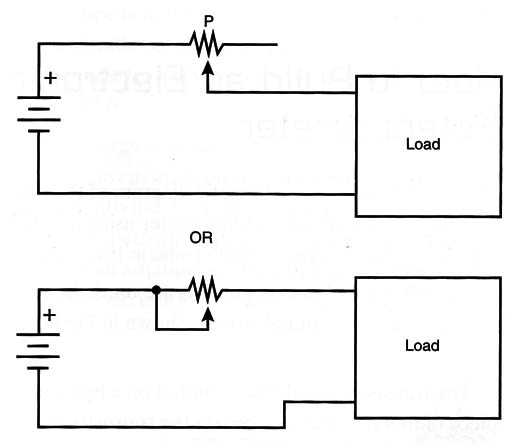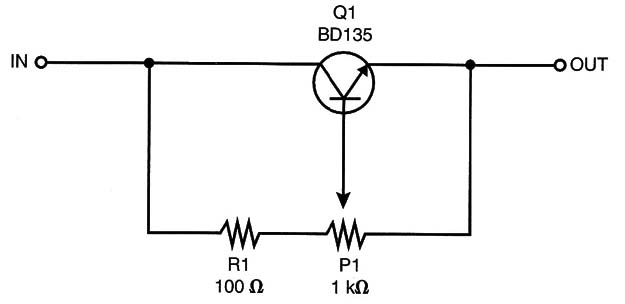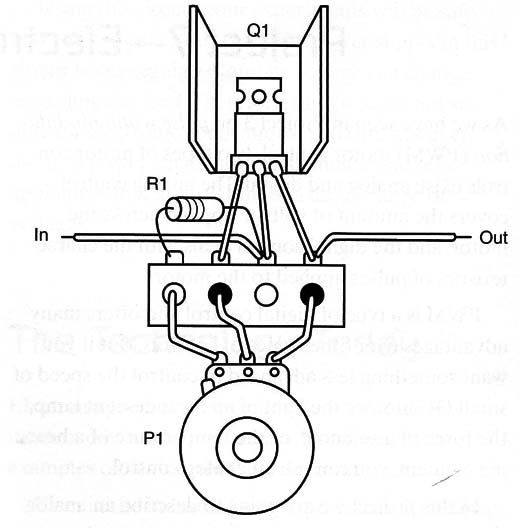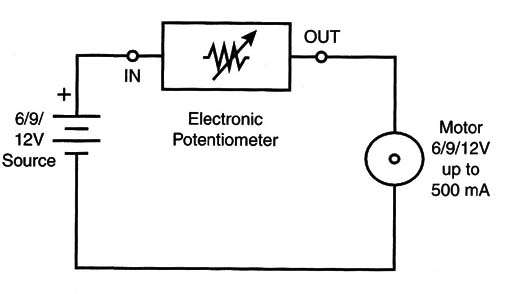PWM is a type of digital control and offers many advantages over other types of controls. But if you want something less advanced to control the speed of small DC motors, the light of an incandescent lamp, the force of a solenoid, or the temperature of a heating element, you can use an analog control.
In this project we are going to describe an analog power control or simply an electronic potentiometer using only three components. You will be able to experiment and build some mechatronic appliances based on the project with this type of power control.
It’s really simple. You need only attach the control between the fixed power supply, such as a battery, and the load to be controlled to get a perfect control of the amount of current flowing across the circuit.
Uses:
Have a complete control for DC loads like motors, lamps, light-emitting diodes (LEDs), and so on.
Do experiments with loads that need a power control.
Build mechatronic projects using DC loads that need a power control (e.g., elevators, race cars, and fans).
How it Works
The circuit in this project uses a common, medium-power, negative-positive-negative (NPN) transistor to control the current flowing across a load. The control element is a carbon potentiometer.
Before we go any further, let’s look at the differences between a potentiometer and a rheostat. A rheostat is a variable resistor connected so that it controls the amount of current in the circuit, and some types of potentiometers are specifically designed to be used like a rheostat.
These devices have only two terminals. See Projecton PWM control of DC motors in this section of the site for more details about the operation of this circuit.
Some applications require a variable resistor, which has three terminals. When we wire components using all three terminals, we say that they are working as potentiometers.
A potentiometer measures and divides the voltage. But we can also use a three-terminal variable resistor as a rheostat by wiring only two terminals, as shown in Figure 1.

This project is used to control the amount of current in a circuit and requires only two terminals; therefore, we can call the project a rheostat.
However, as we are using an electronic component called a potentiometer as base of the design, we can also call the project an electronic potentiometer. The reader will not be wrong to use either of the names.
The current flowing through the potentiometer is very low. It follows that the power dissipation is also very low and that no special type of potentiometer, such as a wire-wound potentiometer, is required.
In this kind of project, the amount of current that can be controlled depends primarily on the transistor used. The project given here uses a BD135 transistor, which can control up to 500 mA.
However, the reader has some options to use a more or less powerful transistor, as shown in the following table.
| Transistor | Maximum Load Current | R1/P1 |
| 2N2222, BC548 | 100 mA | 220Ω ½ W/4,7 kΩ |
| BD135,BD137,BD139 | 500 mA | 100Ω 1 W/1 kΩ |
| TIP31/A/B/C | 2 A | 100Ω 2 W/1 kΩ* |
| 2N3055 | 5 A | 100Ω 5 W/1 kΩ |
*Wire wound
The circuit will operate using power sources of up to 12 volts.
Figure 2 shows the schematic diagram of the basic version of an electronic potentiometer using a BD135 negative-positive-negative (NPN) silicon transistor.

As only a very few components are used, they can be soldered to a terminal strip, as shown in Figure 3.

The transistor should be mounted on a heatsink. A piece of metal board screwed on the transistor is a good way to create a heatsink for this project.
However, if you intend to control heavy-duty loads (above 1 amp) using powerful transistors, it is a good idea to mount the transistor in a large commercial heatsink.
It is important to verify the terminal’s placement if you are using a transistor other than the one recommended in the basic project. Each transistor can have its own pin placement. An example is shown in Figure 4.

The electronic potentiometer can be housed in a small plastic box or added to the box housing the circuit that is to be controlled. Terminal strips or alligator clips are suggested to connect the electronic potentiometer to the power supply and to the circuit to be controlled.
Using the Potentiometer
The circuit will operate using input voltages between 3 and 12 volts and current loads up to 1 amp. Wire the inputs IN+ and IN- to the power supply.
Take care to position them correctly as those wires are polarizedTerminals OUT+ and OUT- should be wired to the load to be controlled.
Monitor P1 to see how the amount of power applied to the load changes. You can use a small lamp (12 V X 200 mA) to test the potentiometer.
The changes in the applied power will cause the lamp to change its brightness.
If the transistor heats up too much when controlling a load and the load does not reach the maximum power, don’t use the potentiometer with it. The current drained by the load is greater than the maximum current the potentiometer can supply.
Exploring the Project
This project is not built to be used alone. It is designed to be inserted between a power supply and a load to be controlled. Figure 5 shows a typical use of the electronic potentiometer.

The reader can now use his or her imagination and skills to design a good project to be controlled by this potentiometer and create more interesting experi ments to learn more about mechatronics and science.
Q1 - BD135 medium-power NPN silicon transistor (see text for equivalents)
R1 - 100-ohm, 1-watt, 5 percent resistor (brown, black, brown)
P1 - 1,000-ohm potentiometer, carbon type
Terminal strip, heatsink for the transistor, knob for the potentiometer, plastic box, wires, solder, etc.




